Lancia Thesis 2007 Owner handbook (in English)
Manufacturer: LANCIA, Model Year: 2007, Model line: Thesis, Model: Lancia Thesis 2007Pages: 386, PDF Size: 8.69 MB
Page 81 of 386
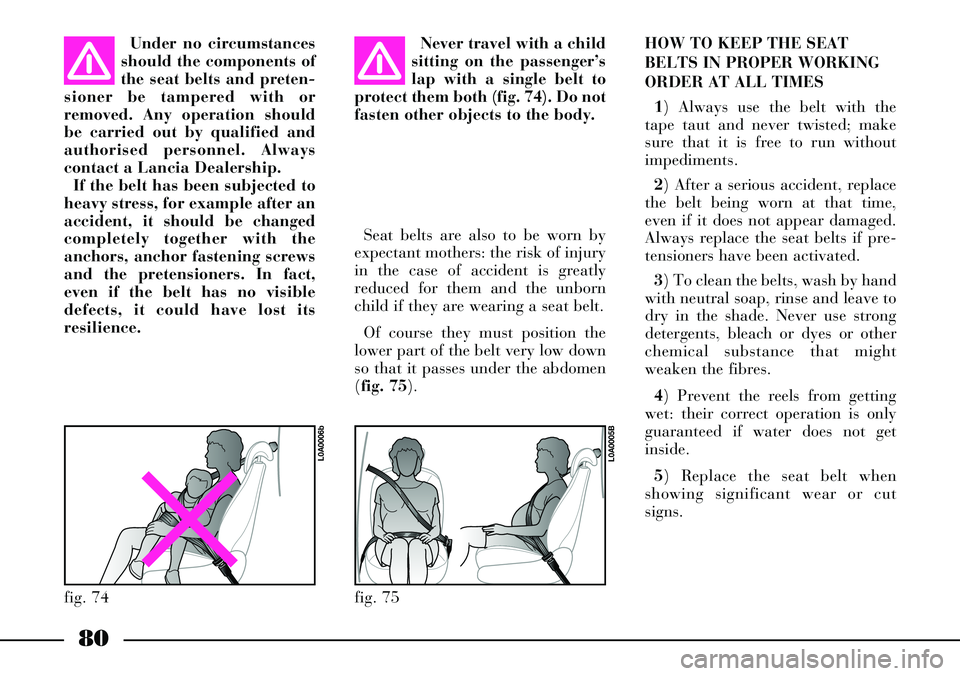
80
Under no circumstances
should the components of
the seat belts and preten-
sioner be tampered with or
removed. Any operation should
be carried out by qualified and
authorised personnel. Always
contact a Lancia Dealership.
If the belt has been subjected to
heavy stress, for example after an
accident, it should be changed
completely together with the
anchors, anchor fastening screws
and the pretensioners. In fact,
even if the belt has no visible
defects, it could have lost its
resilience.Never travel with a child
sitting on the passenger’s
lap with a single belt to
protect them both (fig. 74). Do not
fasten other objects to the body.
Seat belts are also to be worn by
expectant mothers: the risk of injury
in the case of accident is greatly
reduced for them and the unborn
child if they are wearing a seat belt.
Of course they must position the
lower part of the belt very low down
so that it passes under the abdomen
(fig. 75).HOW TO KEEP THE SEAT
BELTS IN PROPER WORKING
ORDER AT ALL TIMES
1) Always use the belt with the
tape taut and never twisted; make
sure that it is free to run without
impediments.
2) After a serious accident, replace
the belt being worn at that time,
even if it does not appear damaged.
Always replace the seat belts if pre-
tensioners have been activated.
3) To clean the belts, wash by hand
with neutral soap, rinse and leave to
dry in the shade. Never use strong
detergents, bleach or dyes or other
chemical substance that might
weaken the fibres.
4) Prevent the reels from getting
wet: their correct operation is only
guaranteed if water does not get
inside.
5) Replace the seat belt when
showing significant wear or cut
signs.
fig. 75
L0A0005B
fig. 74
L0A0006b
Page 82 of 386
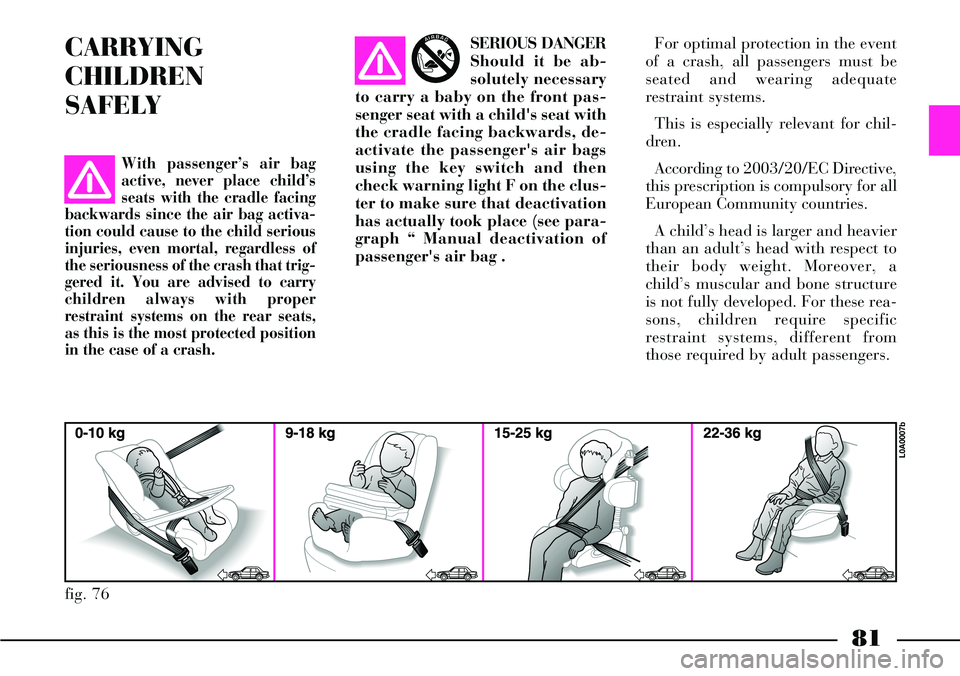
81
CARRYING
CHILDREN
SAFELYSERIOUS DANGER
Should it be ab-
solutely necessary
to carry a baby on the front pas-
senger seat with a child's seat with
the cradle facing backwards, de-
activate the passenger's air bags
using the key switch and then
check warning light F on the clus-
ter to make sure that deactivation
has actually took place (see para-
graph “ Manual deactivation of
passenger's air bag .For optimal protection in the event
of a crash, all passengers must be
seated and wearing adequate
restraint systems.
This is especially relevant for chil-
dren.
According to 2003/20/EC Directive,
this prescription is compulsory for all
European Community countries.
A child’s head is larger and heavier
than an adult’s head with respect to
their body weight. Moreover, a
child’s muscular and bone structure
is not fully developed. For these rea-
sons, children require specific
restraint systems, different from
those required by adult passengers.
fig. 76
L0A0007b
With passenger’s air bag
active, never place child’s
seats with the cradle facing
backwards since the air bag activa-
tion could cause to the child serious
injuries, even mortal, regardless of
the seriousness of the crash that trig-
gered it. You are advised to carry
children always with proper
restraint systems on the rear seats,
as this is the most protected position
in the case of a crash.
AIRBAG
Page 83 of 386
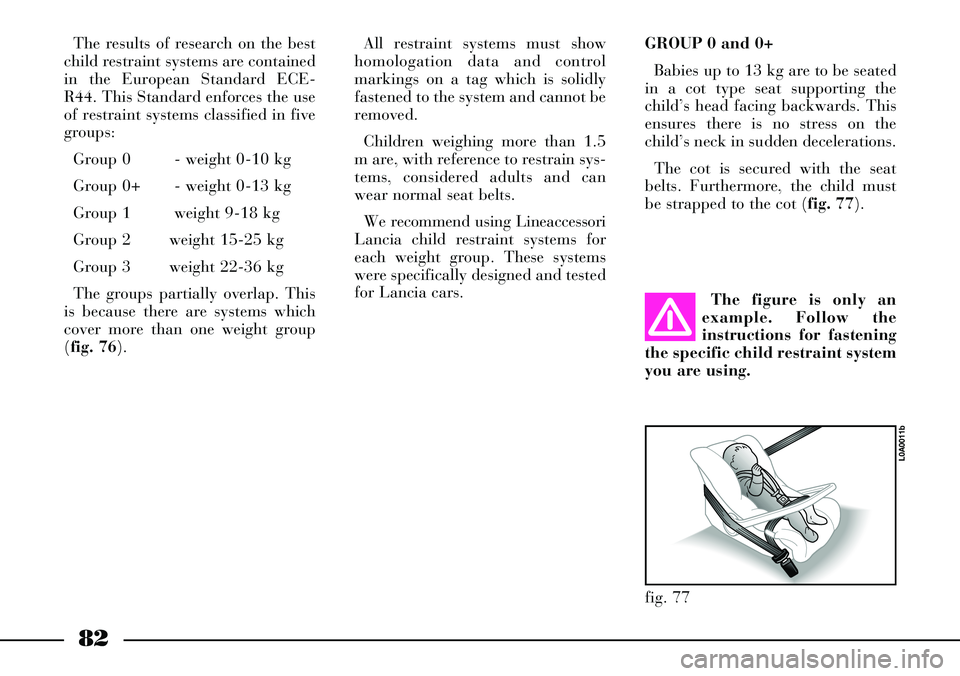
82
The results of research on the best
child restraint systems are contained
in the European Standard ECE-
R44. This Standard enforces the use
of restraint systems classified in five
groups:
Group 0 - weight 0-10 kg
Group 0+ - weight 0-13 kg
Group 1 weight 9-18 kg
Group 2 weight 15-25 kg
Group 3 weight 22-36 kg
The groups partially overlap. This
is because there are systems which
cover more than one weight group
(fig. 76).All restraint systems must show
homologation data and control
markings on a tag which is solidly
fastened to the system and cannot be
removed.
Children weighing more than 1.5
m are, with reference to restrain sys-
tems, considered adults and can
wear normal seat belts.
We recommend using Lineaccessori
Lancia child restraint systems for
each weight group. These systems
were specifically designed and tested
for Lancia cars.GROUP 0 and 0+
Babies up to 13 kg are to be seated
in a cot type seat supporting the
child’s head facing backwards. This
ensures there is no stress on the
child’s neck in sudden decelerations.
The cot is secured with the seat
belts. Furthermore, the child must
be strapped to the cot (fig. 77).
The figure is only an
example. Follow the
instructions for fastening
the specific child restraint system
you are using.
fig. 77
L0A0011b
Page 84 of 386
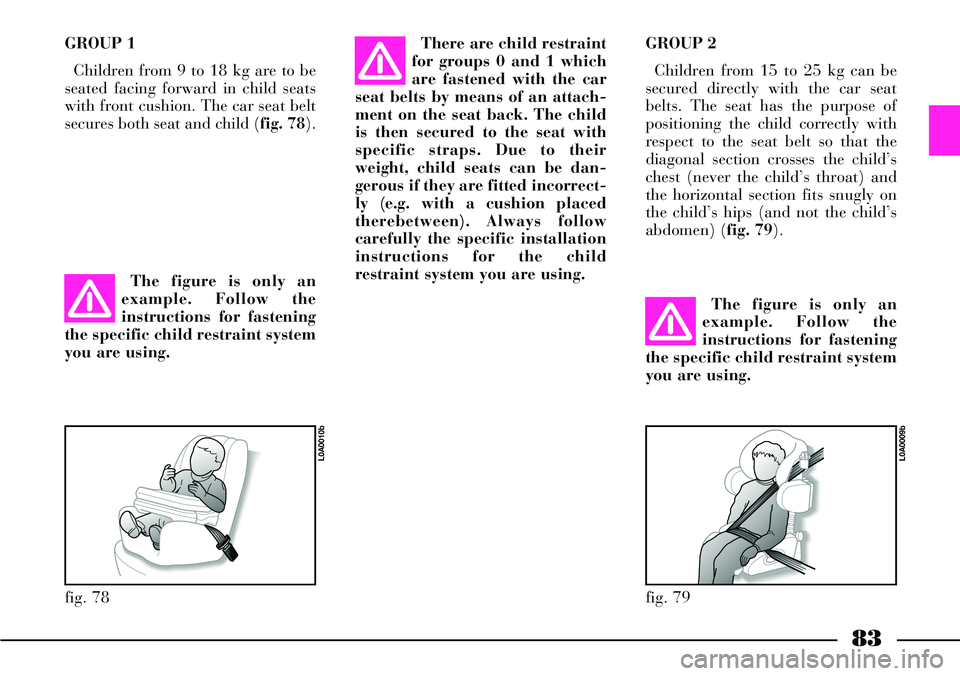
83
GROUP 1
Children from 9 to 18 kg are to be
seated facing forward in child seats
with front cushion. The car seat belt
secures both seat and child (fig. 78).There are child restraint
for groups 0 and 1 which
are fastened with the car
seat belts by means of an attach-
ment on the seat back. The child
is then secured to the seat with
specific straps. Due to their
weight, child seats can be dan-
gerous if they are fitted incorrect-
ly (e.g. with a cushion placed
therebetween). Always follow
carefully the specific installation
instructions for the child
restraint system you are using.GROUP 2
Children from 15 to 25 kg can be
secured directly with the car seat
belts. The seat has the purpose of
positioning the child correctly with
respect to the seat belt so that the
diagonal section crosses the child’s
chest (never the child’s throat) and
the horizontal section fits snugly on
the child’s hips (and not the child’s
abdomen) (fig. 79).
The figure is only an
example. Follow the
instructions for fastening
the specific child restraint system
you are using.The figure is only an
example. Follow the
instructions for fastening
the specific child restraint system
you are using.
fig. 78
L0A0010b
fig. 79
L0A0009b
Page 85 of 386
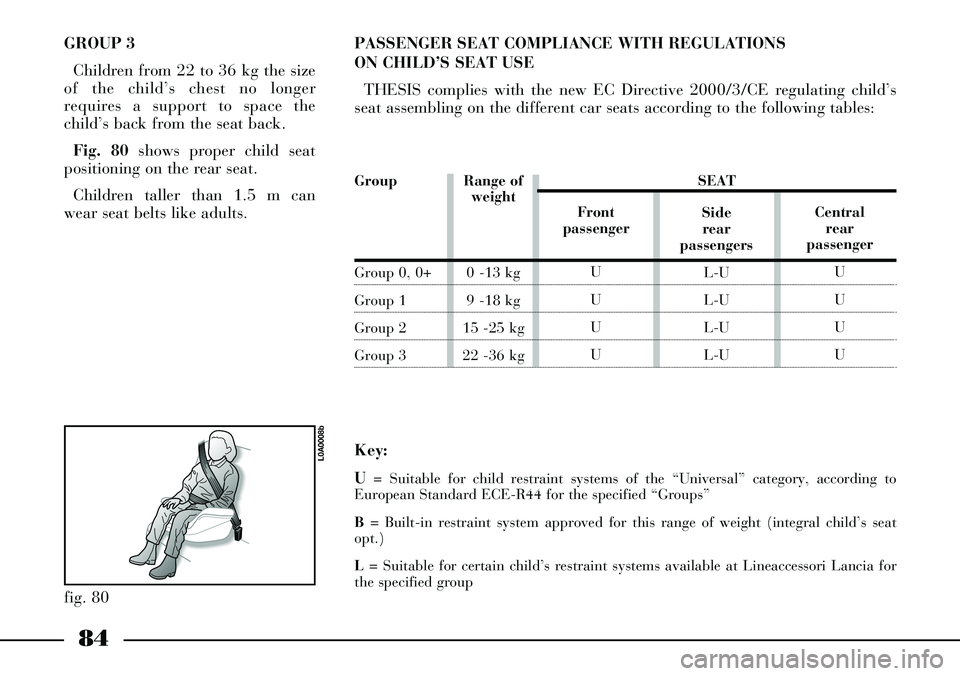
84
GROUP 3
Children from 22 to 36 kg the size
of the child’s chest no longer
requires a support to space the
child’s back from the seat back.
Fig. 80shows proper child seat
positioning on the rear seat.
Children taller than 1.5 m can
wear seat belts like adults.PASSENGER SEAT COMPLIANCE WITH REGULATIONS
ON CHILD’S SEAT USE
THESIS complies with the new EC Directive 2000/3/CE regulating child’s
seat assembling on the different car seats according to the following tables:
Group
Group 0, 0+
Group 1
Group 2
Group 3
Key:
U
= Suitable for child restraint systems of the “Universal” category, according to
European Standard ECE-R44 for the specified “Groups”
B = Built-in restraint system approved for this range of weight (integral child’s seat
opt.)
L = Suitable for certain child’s restraint systems available at Lineaccessori Lancia for
the specified group
fig. 80
L0A0008b
SEAT
Front
passenger
U
U
U
USide
rear
passengers
L-U
L-U
L-U
L-UCentral
rear
passenger
U
U
U
U Range of
weight
0 -13 kg
9 -18 kg
15 -25 kg
22 -36 kg
Page 86 of 386
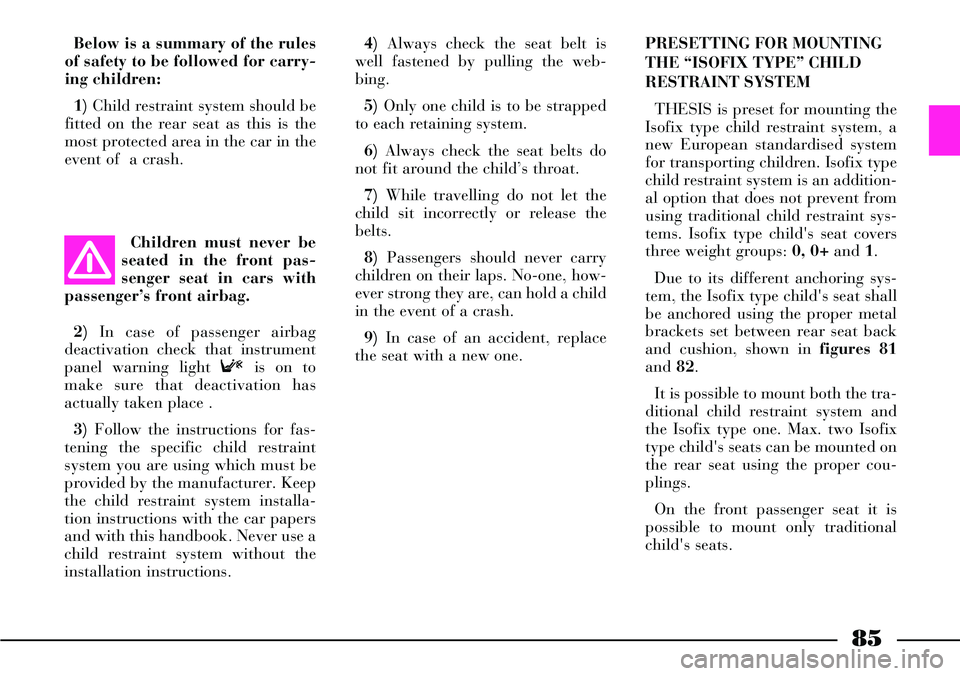
85
Below is a summary of the rules
of safety to be followed for carry-
ing children:
1) Child restraint system should be
fitted on the rear seat as this is the
most protected area in the car in the
event of a crash.4) Always check the seat belt is
well fastened by pulling the web-
bing.
5) Only one child is to be strapped
to each retaining system.
6) Always check the seat belts do
not fit around the child’s throat.
7) While travelling do not let the
child sit incorrectly or release the
belts.
8) Passengers should never carry
children on their laps. No-one, how-
ever strong they are, can hold a child
in the event of a crash.
9) In case of an accident, replace
the seat with a new one.PRESETTING FOR MOUNTING
THE “ISOFIX TYPE” CHILD
RESTRAINT SYSTEM
THESIS is preset for mounting the
Isofix type child restraint system, a
new European standardised system
for transporting children. Isofix type
child restraint system is an addition-
al option that does not prevent from
using traditional child restraint sys-
tems. Isofix type child's seat covers
three weight groups: 0, 0+and 1.
Due to its different anchoring sys-
tem, the Isofix type child's seat shall
be anchored using the proper metal
brackets set between rear seat back
and cushion, shown in figures 81
and82.
It is possible to mount both the tra-
ditional child restraint system and
the Isofix type one. Max. two Isofix
type child's seats can be mounted on
the rear seat using the proper cou-
plings.
On the front passenger seat it is
possible to mount only traditional
child's seats. Children must never be
seated in the front pas-
senger seat in cars with
passenger’s front airbag.
2) In case of passenger airbag
deactivation check that instrument
panel warning light Fis on to
make sure that deactivation has
actually taken place .
3) Follow the instructions for fas-
tening the specific child restraint
system you are using which must be
provided by the manufacturer. Keep
the child restraint system installa-
tion instructions with the car papers
and with this handbook. Never use a
child restraint system without the
installation instructions.
Page 87 of 386

86
Only use Isofix type child restraint
systems specifically designed, tested
and approved for this car.Mount the child
restraint system only with
the car stationary. The
Isofix child restraint system is
properly anchored to the mount-
ing brackets when clicks are
heard. In any case, keep to the
installation instructions that
must be provided by the child
restraint system’s Manufacturer.Mounting the ISOFIX TYPE
child restraint system
Groups 0 and 0+
For children included in this
weight group (up to 13 kg) the
restraint system faces back and the
child is held by the restraint system
belts D(fig. 83).
fig. 81
L0A0271b
fig. 82
L0A0270b
fig. 83
L0A0254b
Page 88 of 386
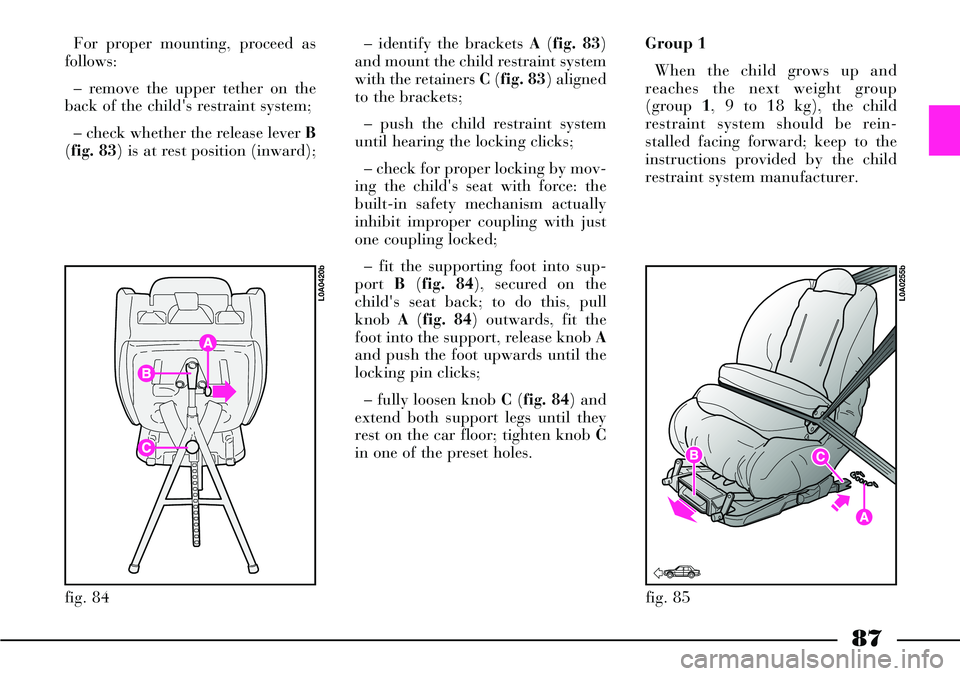
87
fig. 84
L0A0420b
fig. 85
L0A0255b
For proper mounting, proceed as
follows:
– remove the upper tether on the
back of the child's restraint system;
– check whether the release lever B
(fig. 83) is at rest position (inward);– identify the brackets A(fig. 83)
and mount the child restraint system
with the retainers C(fig. 83) aligned
to the brackets;
– push the child restraint system
until hearing the locking clicks;
– check for proper locking by mov-
ing the child's seat with force: the
built-in safety mechanism actually
inhibit improper coupling with just
one coupling locked;
– fit the supporting foot into sup-
port B(fig. 84), secured on the
child's seat back; to do this, pull
knob A(fig. 84) outwards, fit the
foot into the support, release knob A
and push the foot upwards until the
locking pin clicks;
– fully loosen knob C(fig. 84) and
extend both support legs until they
rest on the car floor; tighten knob C
in one of the preset holes.Group 1
When the child grows up and
reaches the next weight group
(group 1, 9 to 18 kg), the child
restraint system should be rein-
stalled facing forward; keep to the
instructions provided by the child
restraint system manufacturer.
Page 89 of 386
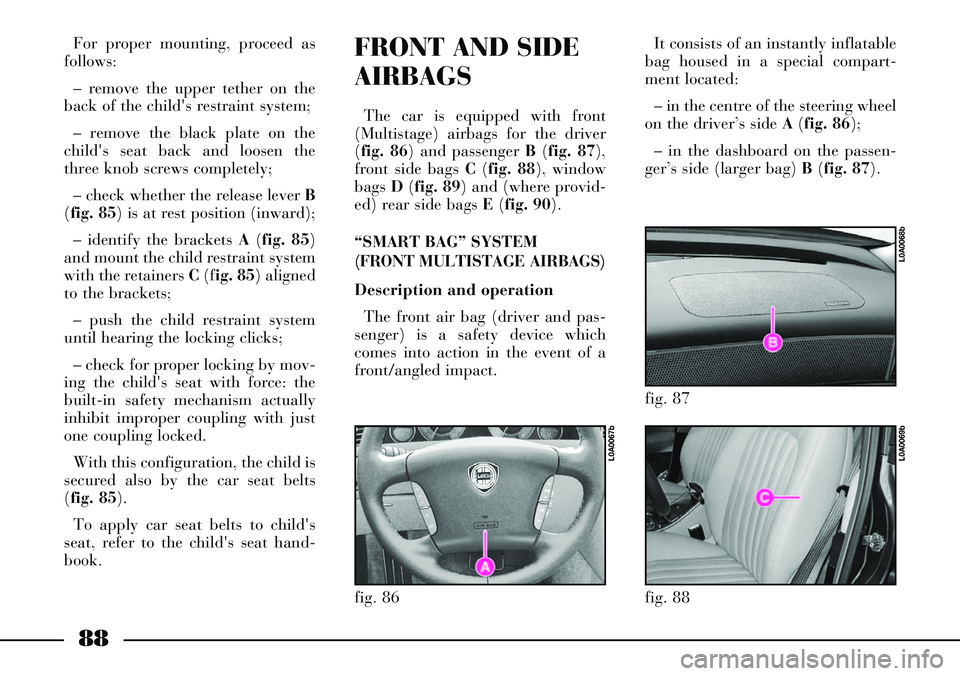
88
FRONT AND SIDE
AIRBAGS
The car is equipped with front
(Multistage) airbags for the driver
(fig. 86) and passenger B(fig. 87),
front side bags C (fig. 88), window
bags D(fig. 89) and (where provid-
ed) rear side bags E(fig. 90).
“SMART BAG” SYSTEM
(FRONT MULTISTAGE AIRBAGS)
Description and operation
The front air bag (driver and pas-
senger) is a safety device which
comes into action in the event of a
front/angled impact.
fig. 86
L0A0067b
For proper mounting, proceed as
follows:
– remove the upper tether on the
back of the child's restraint system;
– remove the black plate on the
child's seat back and loosen the
three knob screws completely;
– check whether the release lever B
(fig. 85) is at rest position (inward);
– identify the brackets A(fig. 85)
and mount the child restraint system
with the retainers C(fig. 85) aligned
to the brackets;
– push the child restraint system
until hearing the locking clicks;
– check for proper locking by mov-
ing the child's seat with force: the
built-in safety mechanism actually
inhibit improper coupling with just
one coupling locked.
With this configuration, the child is
secured also by the car seat belts
(fig. 85).
To apply car seat belts to child's
seat, refer to the child's seat hand-
book.It consists of an instantly inflatable
bag housed in a special compart-
ment located:
– in the centre of the steering wheel
on the driver’s side A (fig. 86);
– in the dashboard on the passen-
ger’s side (larger bag) B(fig. 87).
fig. 87
L0A0068b
fig. 88
L0A0069b
Page 90 of 386
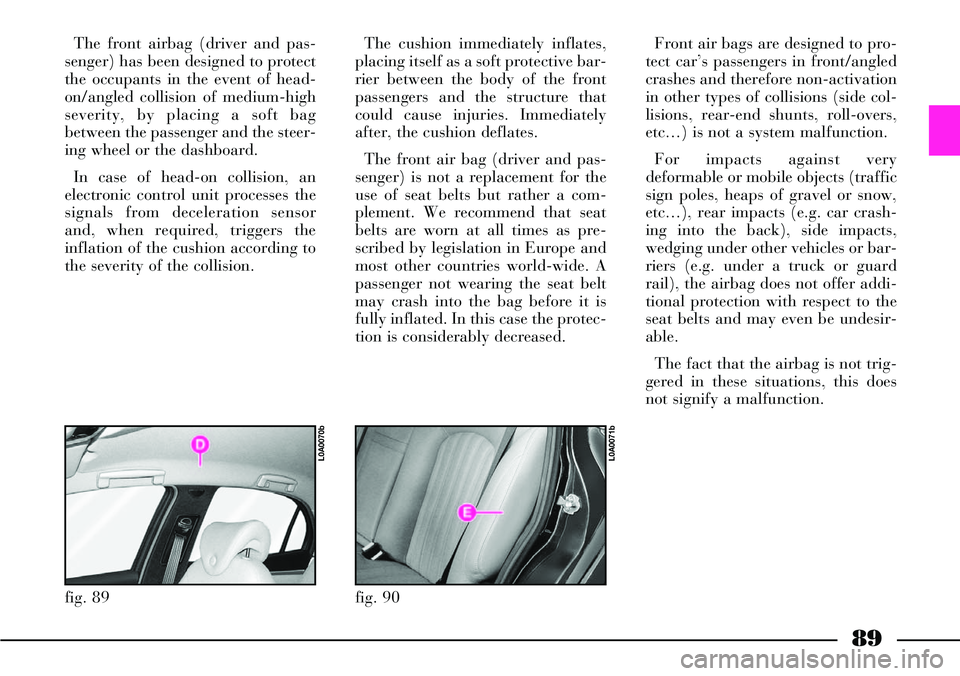
89
The front airbag (driver and pas-
senger) has been designed to protect
the occupants in the event of head-
on/angled collision of medium-high
severity, by placing a soft bag
between the passenger and the steer-
ing wheel or the dashboard.
In case of head-on collision, an
electronic control unit processes the
signals from deceleration sensor
and, when required, triggers the
inflation of the cushion according to
the severity of the collision.
fig. 89
L0A0070b
The cushion immediately inflates,
placing itself as a soft protective bar-
rier between the body of the front
passengers and the structure that
could cause injuries. Immediately
after, the cushion deflates.
The front air bag (driver and pas-
senger) is not a replacement for the
use of seat belts but rather a com-
plement. We recommend that seat
belts are worn at all times as pre-
scribed by legislation in Europe and
most other countries world-wide. A
passenger not wearing the seat belt
may crash into the bag before it is
fully inflated. In this case the protec-
tion is considerably decreased.
fig. 90
L0A0071b
Front air bags are designed to pro-
tect car’s passengers in front/angled
crashes and therefore non-activation
in other types of collisions (side col-
lisions, rear-end shunts, roll-overs,
etc…) is not a system malfunction.
For impacts against very
deformable or mobile objects (traffic
sign poles, heaps of gravel or snow,
etc…), rear impacts (e.g. car crash-
ing into the back), side impacts,
wedging under other vehicles or bar-
riers (e.g. under a truck or guard
rail), the airbag does not offer addi-
tional protection with respect to the
seat belts and may even be undesir-
able.
The fact that the airbag is not trig-
gered in these situations, this does
not signify a malfunction.